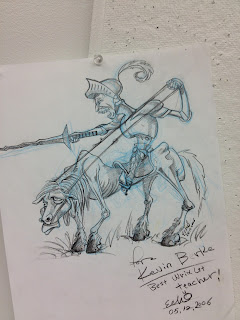It's not hard to draw figures but one mustn't rush and skip the most important part of the training--gestural drawings. These are simple quick studies on human bodies with no details but indications of the line of action, as well as the proportion of the figure.
Tuesday, September 25, 2012
Sunday, September 23, 2012
Thursday, September 20, 2012
Thought and drafting process in storyboard and comics.
1.Student Draft
This is a rather simple storyboard, the student is doing a good job paying attention to the shot flows and perspective. However, there are things we should ALWAYS keep in mind when working on even a simple project like this.
1. CHARACTER yey ou nay? Whether your story is based on characters or reversed process, you should always spend a great amount of time studying and designing your characters. Becoming comfortable with your own character is extremely vital to the viewers. (em..duh!) Research is so easy today as everything can be found with a click of button, so take advantage of it! Make them lively and likable, remember we are animals of interest, without it we cant be enthusiastic about your work!
 |
| Character study & Design |
2. PERSPECTIVE: Dont' be afraid of perspective, it is after all, your best friend. Draw it out, work things out before making any framing decisions. It is ALWAYS easier and more natural if you understand the perspective beyond the frames. For example, when we take photos we use the view finder to find the perfect shot, right? No one would ask people to try to fit the view finder instead because that would be awkward.
3. SHOT CHOICES: Shot choices can both resolve and elevate; "resolve" in the sense that switching cameras angles don't necessarily create disconnection between panel and characters. Look at p.1 & 2 for instance, we begin with a establishing shot of the exterior of the restaurant, p.2 (assuming) the camera moves through the front door and now we see one character sitting somewha far away from the camera. Now we want to know who this person is and what he is doing there, so p.3 shows a great profile of him (a large, fit, seemingly confident feline?) P.5, is the student's original camera view. It describes two things--1. The cat has his soup and is about to begin. 2. The waiter walks away. P.6 zooms into the character as he begins to sip the soup.
Oh no! what's wrong? --- such suspension in p.8 raises further interest, forcing the viewers to be curious as to the sudden change of event. Remember using diagonal design! In the original work, the last panel indicates a flat close up right on the cat's eye level, is that enough for the story? How about changing the perspective a bit and making the camera look up, as the cat suddenly becomes aware of something below, possibly in the soup? THAT'S "CONNECTION"!
Tuesday, September 11, 2012
Have fun with The Design!
Animation folks, if you missed the last class, here's a summery of it.
*Don't forget to start you sketch book now!
*Don't forget to start you sketch book now!
Sunday, September 9, 2012
For Students
Animation folks, when it comes to figures, think of them as simple forms--cylinder, sphere and squares. Don't worry about any details for now, those you will learn if you continue to see figures as training priority. Hands and feet will become easy if you know how bones and muscles function under the skin. Always ask questions!
Tuesday, September 4, 2012
Save the DATE!
Join me at the Delaware College of Art & Design, this Friday, September 7th for the annual faculty show.
Read more about the show here.
Saturday, September 1, 2012
Great week /:)
The first week of teaching was ecstatic! The
students are great and willing to learn. Before entering into the world
of competition and constant despair, they should have as much fun as
possible while in art school to inspire growth both as person and as
artist. Here is an example of student work and the revision process where I help organizing the panels based on their work, selecting camera angles and playing out the "great dramatist".
Subscribe to:
Comments (Atom)
























